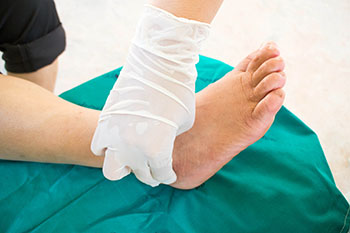
Foot Wound Care in Chicago, IL
Wounds on the feet are a common occurrence in people who have diabetes. This is because those with diabetes also tend to have peripheral neuropathy and circulatory issues, which are two common complications of diabetes that affect the feet. The combination of these two secondary diseases can lead to the development of wounds and, ultimately, non-healing wounds (ulcers).
How Does a Diabetic Foot Wound Develop?
Diabetic neuropathy is a type of nerve damage that can cause loss of sensation in the lower limbs, and poor blood circulation. Numbness in the feet can make it difficult or even impossible for the diabetic to detect an injury to the skin on the feet. Thus, any small cut, scrape, or sore on diabetic feet may go unnoticed. Not being aware of these injuries prevents a person from treating it. Meanwhile, poor blood flow to the area can mean that any injury will heal slowly, poorly, or not at all. Left undetected and untreated, even small wounds can become diabetic foot ulcers (DFUs), which can become infected and lead to serious medical complications, up to and including amputation in the worst-case scenarios.
When Diabetic Wounds Don’t Heal
Wounds in a person with diabetes can be dangerous. A diabetic wound can heal slowly, not heal properly, or in some cases, never heal, making it an ulcer. Ulcers that are not healed promptly and properly have the potential of becoming infected and, sometimes, this infection may even spread to nearby tissue and bone, which is a serious health issue. An infection, and/or lack of blood flow can cause tissue to die, which is known as gangrene. Dead tissue must be surgically removed to prevent bacteria from entering and spreading through the bloodstream. This procedure is known as debridement. Early detection and intervention are extremely important in mitigating the risk to healthy tissue, and to prevent an amputation from becoming necessary.
Wound Prevention
Fortunately, there are steps that those with diabetes can take to care for their feet and prevent the formation of DFUs. Along with managing their glucose levels and inspecting their feet daily, diabetic patients should take care of their feet every day. People with diabetes should wear shoes and socks when walking to avoid foot injuries. The shoes should fit properly, cushion the feet, and have a low heel. Feet should be washed and dried daily, toenails should be carefully trimmed. When trimming the toenails, nail clippers should be used to cut the nails straight across and not too short. This helps prevent ingrown toenails, which can become infected and lead to DFUs. Finally, it is important to be vigilant of any potential foot problems by inspecting the feet daily for any irregularities, such as cuts, scrapes, sores, discoloration, swelling, cracked skin, redness, bumps, lumps, ingrown toenails, pain, or any strange sensations like numbness, burning, or tingling. Anything out of the ordinary should be reported to a podiatrist immediately.
To learn more about how to care for diabetic feet and prevent and treat foot wounds, please speak with a podiatrist.
